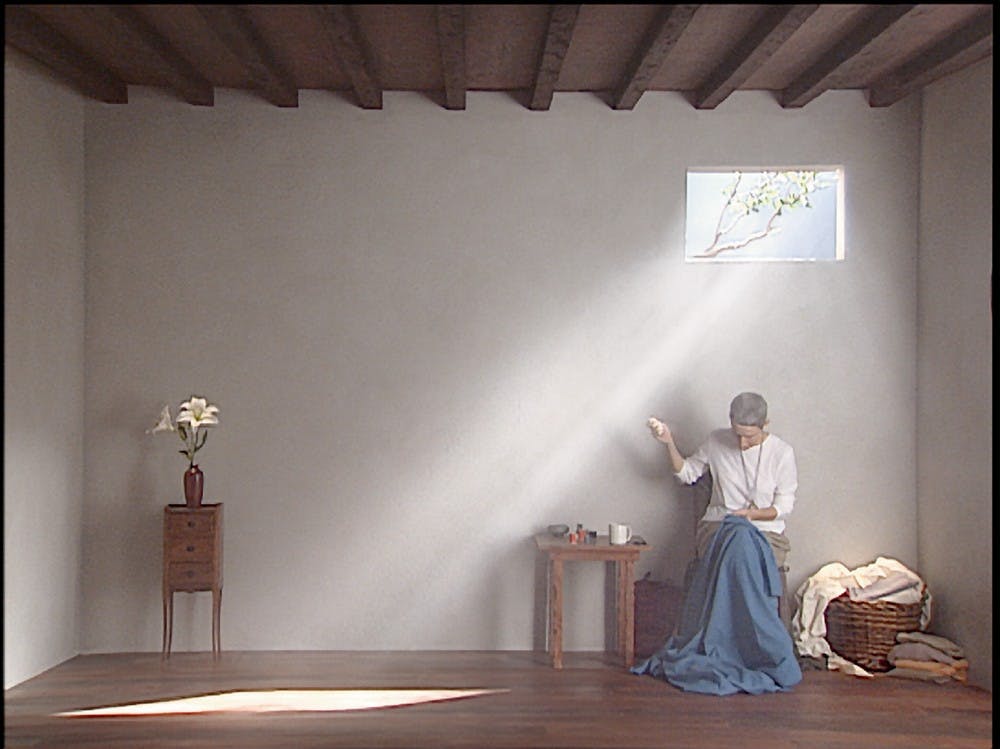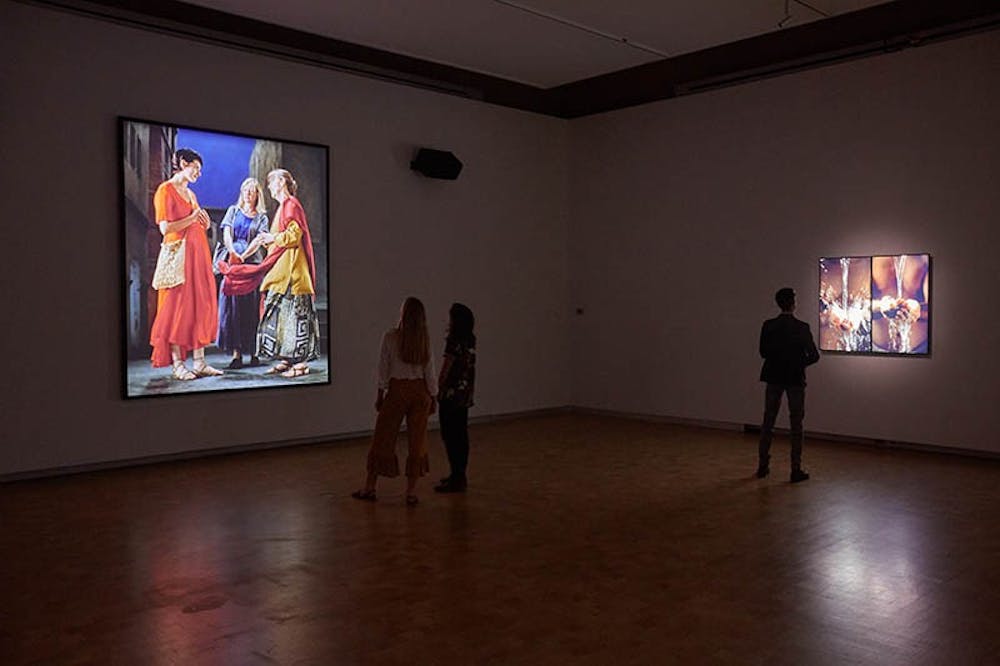What is the human condition, really? This is a question that demands meditation, restraint, commitment, and, when the answer comes in the form of video art, extreme patience. That answer takes shape in the Barnes Foundation’s latest special exhibition, I Do Not Know What It Is I Am Like, which displays seven works by Bill Viola, an American artist specializing in experimental video art. This exhibition, containing pieces from the years 1976 to 2009, looks with slow and quiet detail at our behaviors, our expressions, and our rituals as human beings throughout all of time.
One of the most mesmerizing pieces is Ablutions (2005), located in the first room of the exhibition, where four different works project continuously onto each of the four walls. A deep and enveloping darkness carries the exhibition away from the bright summer light of the central Annenberg Court of the museum, an otherworldly transition underscored by the focused isolation of the videos that follow. Religious and ritualistic, the work that seems to most consistently transfix its viewers is Ablutions, a split–screen ten–minute video of a man and a woman washing their hands in steady streams of falling water. An ablution in Christianity is a ceremonial act of washing, most often performed during baptism, meant to symbolize purification—the sort of mental cleansing that feels necessary before the rest of the exhibition can be considered. Though Ablutions is ten minutes in length, if fully watched, the balance between the two figures and the constancy of the hypnotic running water wash away any impurities that might impinge on the same patient perception the other six works require.
Apart from Ablutions, the first room also contains The Greeting (1995), inspired by Jacopo de Pontormo’s Mannerist altarpiece painting, The Visitation, though Viola’s rendition has only three women. Despite elements of modernity in the women’s haircuts and shoulder bags, The Greeting retains the vibrantly billowing fabrics and Mediterranean setting of Pontormo’s original, with Viola’s use of slow motion allowing for the notice of minute details as if the video were really a painting. These similarities between The Greeting and Pontormo’s 16th century altarpiece demonstrate the way that the mannerisms of certain human communications and traditions remain largely unchanged even after hundreds of years.

This sense of ritual continues into Catherine’s Room (2001), a five–paneled video of a woman performing a series of tasks from morning to night in her daily routine. Though the room and camera angle remain constant in each, the furniture changes and moves position as the woman practices yoga, needlework, and writing, before lighting a roomful of prayer candles and then making her bed to fall asleep in the rightmost panel. With a structure modeled after a predella—a platform upon which altarpieces stand—the videos reveal the cyclical nature of time and human life, particularly as a single window in the room displays changing seasons across each panel. Despite the complexity of layered time in the videos themselves and their allusions to religious art, there is an undeniably simple comfort that comes from watching the woman go about her activities over and over again, recognizing my own patterns within hers.
The fifth piece in the exhibition, Ascension (2000), is the culmination of the religious and ritualistic elements in the four pieces that precede it. Projected on nearly the entire wall of its own room, Ascension shows a fully clothed man plunging into water, feet–first, from the top of the screen to the bottom. Our viewpoint is entirely underwater, with so little light that I could almost feel my pupils dilate in the darkness. Again in slow motion, the moments in which the figure is not present feel so long that the deep blackish blue of the undisturbed water becomes a solemn peace, before being interrupted once more by the figure’s quick plunge downward, and his slow rise and fall that follows. With outstretched arms and a limp body, the man seems to have no control over his actions, and his vulnerability to both the water and the darkness increase as he falls out of our view forever, alluding in many ways to the ascension of Jesus, in figure and in fate.

Where these first five pieces give us something to watch, the final two ask us to look. In Pneuma (1994/2009), three walls of a room have projections of blurred security–camera–like videos, where shifts in light make figures and objects nearly unidentifiable. The longer we stare, the more unrecognizable their reality becomes, and the vague translation of its title seems to find a home in the way these ambiguous shadows emulate our senses, our memories, and our essences. And in He Weeps For You (1976), the earliest work of the exhibition, we see ourselves, projected upside down and unfocused through a video trained on a droplet of water falling from a copper pipe. Here, the drop never stops dropping, indifferent to our presence despite the intimacy of the work’s title. In this final piece, Viola makes us witness to a sort of infinity—whether we stay or leave will not interrupt, halt, or slow the drop from falling, yet so long as we are there, our reflections can become a brief part of its comforting perpetuity.
The worst part of this exhibition is its end, not for poignant reasons, or even reflective ones, but because I, like many who visit the museum, chose to pay my respects to the Foundation’s permanent collection afterward. For those unfamiliar with the setup of most rooms in the museum, the gallery walls are known for their lack of labels and careful arrangement of multimedia art, from antique door hinges to Renoir nudes to Renaissance–era religious portraits, in an effort to establish a unification of stylistic and thematic similarities. And sometimes it works.
But the sticking power that derives from a prolonged viewing of undeniably good art—the kind that will come without fail from Viola’s—doesn’t hold up well in the face of the main collection. The similarities seem weaker, the points being made more diffident, the conversation between the pieces scrambled into cacophony. They are rewarding in analysis of form or color, but as far as making statements about the unifying aspects of the human condition, those should be left to Viola. Because even as I stood in front of my long–time favorites of the main collection, my mind couldn’t help but drift back to the dropping water in that final piece of the exhibition, and wonder if it really was still going.
I Do Not Know What It Is I Am Like: The Art of Bill Viola will run through September 15. Student tickets are $5.

